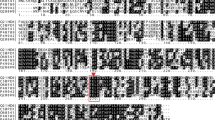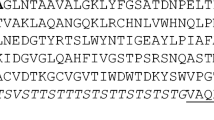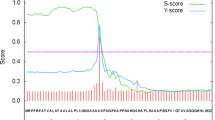Abstract
A cDNA encoding a bifunctional acetylxylan esterase/xylanase, XynS20E, was cloned from the ruminal fungus Neocallimastix patriciarum. A putative conserved domain of carbohydrate esterase family 1 was observed at the N-terminus and a putative conserved domain of glycosyl hydrolase family 11 was detected at the C-terminus of XynS20E. To examine the enzyme activities, XynS20E was expressed in Escherichia coli as a recombinant His6 fusion protein and purified by immobilized metal ion-affinity chromatography. Response surface modeling combined with central composite design and regression analysis was then applied to determine the optimal temperature and pH conditions of the recombinant XynS20E. The optimal conditions for the highest xylanase activity of the recombinant XynS20E were observed at a temperature of 49°C and a pH of 5.8, while those for the highest carbohydrate esterase activity were observed at a temperature of 58°C and a pH of 8.2. Under the optimal conditions for the enzyme activity, the xylanase and acetylxylan esterase specific activities of the recombinant XynS20E toward birchwood xylan were 128.7 and 873.1 U mg−1, respectively. To our knowledge, this is the first report of a bifunctional xylanolytic enzyme with acetylxylan esterase and xylanase activities from rumen fungus.



Similar content being viewed by others
References
Akhnazarova S, Kafarov V (1982) Experiment optimization in chemistry and chemical engineering. Mir, Moscow
Aurilia V, Martin JC, McCrae SI, Scott KP, Rincon MT, Flint HJ (2000) Three multidomain esterases from the cellulolytic rumen anaerobe Ruminococcus flavefaciens 17 that carry divergent dockerin sequences. Microbiology 146:1391–1397
Blum DL, Kataeva IA, Li XL, Ljungdahl LG (2000) Feruloyl esterase activity of the Clostridium thermocellum cellulosome can be attributed to previously unknown domains of XynY and XynZ. J Bacteriol 182:1346–1351
Blum DL, Li XL, Chen H, Ljungdahl LG (1999) Characterization of an acetyl xylan esterase from the anaerobic fungus Orpinomyces sp. strain PC-2. Appl Environ Microbiol 65:3990–3995
Cepeljnik T, Rincon MT, Flint HJ, Logar R (2006) Xyn11A, a multidomain multicatalytic enzyme from Pseudobutyrivibrio xylanivorans Mz5T. Folia Microbiol 51:263–267
Collins T, Gerday C, Feller G (2005) Xylanases, xylanase families and extremophilic xylanases. FEMS Microbiol Rev 29:3–23
Cybinski DH, Layton I, Lowry JB, Dalrymaple BP (1999) An acetylxylan esterase and a xylanase expressed from genes cloned from the ruminal fungus Neocallimastix patriciarum act synergistically to degrade acetylated xylans. Appl Microbiol Biotechnol 52:221–225
Dalrymple BP, Cybinski DH, Layton I, McSweeney CS, Xue GP, Swadling YJ, Lowry JB (1997) Three Neocallimastix patriciarum esterases associated with the degradation of complex polysaccharides are members of a new family of hydrolases. Microbiology 143:2605–2614
Ding SJ, Cao J, Zhou R, Zheng F (2007) Molecular cloning, and characterization ofamodularacetyl xylan esterase fromthe edible strawmushroom Volvariella volvacea. FEMS Microbiol Lett 274:304–310
Denman S, Xue GP, Patel B (1996) Characterization of a Neocallimastix patriciarum Cellulase cDNA (celA) Homologous to Trichoderma reesei Cellobiohydrolase II. Appl Environ Microbiol 62:1889–1896
Dupont C, Daigneault N, Shareck F, Morosoli R, Kluepfel D (1996) Purification and characterization of an acetyl xylan esterase produced by Streptomyces lividans. Biochem J 319:881–886
Fanutti C, Ponyi T, Black GW, Hazlewood GP, Gilbert HJ (1995) The conserved noncatalytic 40-residue sequence in cellulases and hemicellulases from anaerobic fungi functions as a protein docking domain. J. Biol. Chem. 270:29314–29322
Ferreira LMA, Wood TM, Williamson G, Faulds C, Hazlewood GP, Black GW, Gilbert HJ (1993) A modular esterase from Pseudomonas fluorescens subsp. cellulosa contains a noncatalytic cellulose-binding domain. Biochem J 294:349–355
Fillingham IJ, Kroon PA, Williamson G, Gilbert HJ, Hazlewood GP (1999) A modular cinnamoyl ester hydrolase from the anaerobic fungus Piromyces equi acts synergistically with xylanase and is part of a multiprotein cellulose-binding cellulase-hemicellulase complex. Biochem J 343:215–224
Halgasova N, Kutejova E, Timko J (1994) Purification and some characteristics of the acetylxylan esterase from Schizophyllum commune. Biochem J 298:751–755
Hall TA (1999) BioEdit: a user-friendly biological sequence alignment editor and analysis. Nucl Acids Symp 41:95–98
Heck JX, Flores SH, Hertz PF, Ayub MAZ (2006) Statistical optimization of thermo-tolerant xylanase activity from Amazon isolated Bacillus circulans on solid-state cultivation. Biores Technol 97:1902–1906
Huang YH, Huang CT, Hseu RS (2005) Effects of dockerin domains on Neocallimastix frontalis xylanases. FEMS Microbiol Lett 243:455–460
Johnson KG, Fontana JD, MacKenzie CR (1988) Measurement of acetylxylan esterase in Streptomyces. Methods Enzymol 160:551–560
Khandeparker R, Numan MT (2008) Bifunctional xylanases and their potential use in biotechnology. J Ind Microbiol Biotechnol 35:635–644
Konig J, Grasser R, Pikor H, Vogel K (2002) Determination of xylanase, β-glucanase, and cellulase activity. Anal Bioanal Chem 374:80–87
Kosugi A, Murashima K, Doi RH (2002) Xylanase and acetyl xylan esterase activities of XynA, a key subunit of the Clostridium cellulovorans cellulosome for xylan degradation. Appl Environ Microbiol 68:6399–6402
Laemmli UK (1970) Cleavage of structural proteins during the assembly of the head of bacteriophage T4. Nature 227:680–685
Lineweaver H, Burk D (1934) The determination of enzyme dissociation constants. J Am Chem Soc 57:685
Liu JR, Duan CH, Zhao X, Tzen JTC, Cheng KJ, Pai CK (2008) Cloning of a rumen fungal xylanase gene and purification of the recombinant enzyme via artificial oil bodies. Appl Microbiol Biotechnol 79:225–233
Lu P, Feng MG (2008) Bifunctional enhancement of a β-glucanase-xylanase fusion enzyme by optimization of peptide linkers. Appl Microbiol Biotechnol 79:579–587
Nagy T, Tunnicliffe RB, Higgins LD, Walters C, Gilbert HJ, Williamson MP (2007) Characterization of a double dockerin from the cellulosome of the anaerobic fungus Piromyces equi. J Mol Biol 373:612–622
Raghothama S, Eberhardt RY, Simpson P, Wigelsworth D, White P, Hazlewood GP (2001) Characterization of a cellulosome dockerin domain from the anaerobic fungus Piromyces equi. Nature Struct Biol 8:775–778
Sambrook J, Russell DW (2001) Molecular cloning: a laboratory manual, 3rd edn. Cold Spring Harbor Laboratory Press, Cold Spring Harbor, NY
Segurola J, Allen NS, Edge M, McMahon A (1999) Design of eutectic photoinitiator blends for UV/visible curable acrylated printing inks and coatings. Prog Org Coat 37:23–37
Selinger LB, Forsberg CW, Cheng KJ (1996) The rumen: a unique source of enzymes for enhancing livestock production. Anaerobe 2:263–284
Shao W, Wiegel J (1995) Purification and characterization of two acetyl xylan esterases from Thermoanaerobacterium sp. strain JW/SL-YS485. Appl Environ Microbiol 1764:263–274
Steenbakkers PJM, Li XL, Ximenes EA, Arts JG, Chen H, Ljungdahl LG, Op Den Camp HJM (2001) Noncatalytic docking domains of cellulosomes of anaerobic fungi. J Bacteriol 183:5325–5333
Subramaniyan S, Prema P (2002) Biotechnology of microbial xylanases: enzymology, molecular biology, and application. Crit Rev Biotechnol 22:33–64
Wakarchuk WW, Campbell RL, Sung WL, Davoodi J, Yaguchi M (1994) Mutational and crystallographic analyses of the active site residues of the Bacillus circulans xylanase. Protein Sci 3:467–475
Xie G, Bruce DC, Challacombe JF, Chertkov O, Detter JC, Gilna P, Han CS, Lucas S, Misra M, Myers GL, Richardson P, Tapia R, Thayer N, Thompson LS, Brettin TS, Henrissat B, Wilson DB, McBride MJ (2007) Genome sequence of the cellulolytic gliding bacterium Cytophaga hutchinsonii. Appl Environ Microbiol 73:3536–3546
Acknowledgments
This research was conducted using funds partially provided by grant NSC 98-2313-B-002-033-MY3 from the National Science Council and grant 97AS-2.1.2-AD-U1(3) from the Council of Agriculture, Republic of China.
Author information
Authors and Affiliations
Corresponding author
Electronic supplementary material
Below is the link to the electronic supplementary material.
Figure S1
HPLC analysis of the amount of acetic acid released from the substrates by XynS20E. (A) Calibration curve with acetic acid standards. (B) Acetic acid standard (12 mM); (C) birchwood xylan (0.5%, w/v) in 100 mM sodium phosphate buffer (pH 8.2) incubated at 52°C for 20 min; (D) birchwood xylan (0.5%, w/v) in 100 mM sodium phosphate buffer (pH 8.2) incubated with 0.1 μg of the purified recombinant XynS20E at 52°C for 20 min (final reaction volume of 300 μl). (DOC 290 kb)
Figure S2
(A) Michaelis–Menten Plot relating the reaction rate V 0 (initial velocity) to the substrate concentration [S]. (B) Lineweaver–Burk plot, plotting the inverse of substrate concentration against the inverse of the initial velocity. (DOC 81 kb)
Rights and permissions
About this article
Cite this article
Pai, CK., Wu, ZY., Chen, MJ. et al. Molecular cloning and characterization of a bifunctional xylanolytic enzyme from Neocallimastix patriciarum . Appl Microbiol Biotechnol 85, 1451–1462 (2010). https://doi.org/10.1007/s00253-009-2175-5
Received:
Revised:
Accepted:
Published:
Issue Date:
DOI: https://doi.org/10.1007/s00253-009-2175-5




